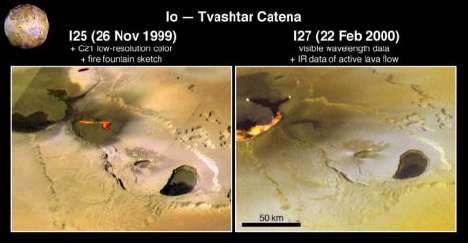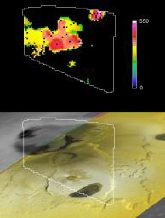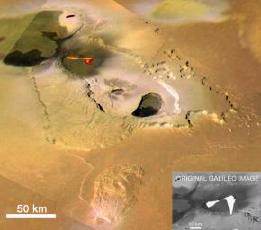Tvashtar

In December 1999, the Galileo spacecraft detected a dynamic eruption at Tvashtar Catena, a chain of volcanic calderas located near Io's north pole. The image above reveals a change in the location of hot lava over a period of a few months from late 1999 to early 2000.
In the second image, the orange and white areas on the left side are places where hot lava has recently erupted. The two small white spots are places where molten rock is exposed at the surface near the edges of the lava flows. The long, yellow and orange stream is more than 60 km long and is a cooling lava flow. The white color in the picture indicates the hottest material in the lava flow, while orange reflects the cooler temperatures. The dark deposits in the vicinity of the active flows were not seen in the image taken in the November, 1999 flyby.
 This
temperature map shows the many locations of hot spots
clustered in the Tvashtar region. The red areas are the
hottest with the highest temperatures reaching about 277
degrees Celsius (530 degrees Fahrenheit). These locations
indicate where new hot lava has come to the
surface.
This
temperature map shows the many locations of hot spots
clustered in the Tvashtar region. The red areas are the
hottest with the highest temperatures reaching about 277
degrees Celsius (530 degrees Fahrenheit). These locations
indicate where new hot lava has come to the
surface.
 The
Tvashtar region also reveals something about erosional
processes on Io. The caldera in the center of this image is
surrounded by a mesa which is about 1 km (0.6 miles) high.
The margins of the mesa appear to be scalloped, a feature
which is typical of a process on Earth called sapping.
Sapping occurs when groundwater seeps through to the surface
at the base of a cliff, weakening the overlying material and
causing it to collapse. Since there is no water on Io, the
fluid driving this process is assumed to be liquid sulfur
dioxide. As the sulfur dioxide reaches the near vacuum of
space at Io's surface, it vaporizes and blasts away material
at the base of the cliffs.
The
Tvashtar region also reveals something about erosional
processes on Io. The caldera in the center of this image is
surrounded by a mesa which is about 1 km (0.6 miles) high.
The margins of the mesa appear to be scalloped, a feature
which is typical of a process on Earth called sapping.
Sapping occurs when groundwater seeps through to the surface
at the base of a cliff, weakening the overlying material and
causing it to collapse. Since there is no water on Io, the
fluid driving this process is assumed to be liquid sulfur
dioxide. As the sulfur dioxide reaches the near vacuum of
space at Io's surface, it vaporizes and blasts away material
at the base of the cliffs.
Photo Credit: NASA/JPL
